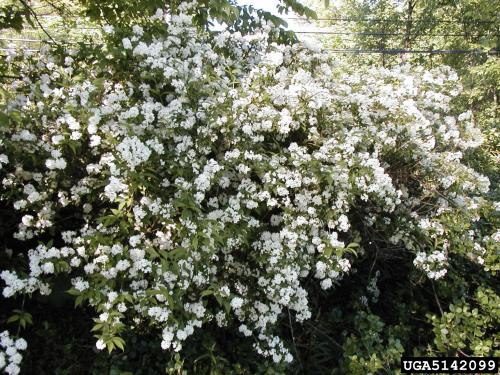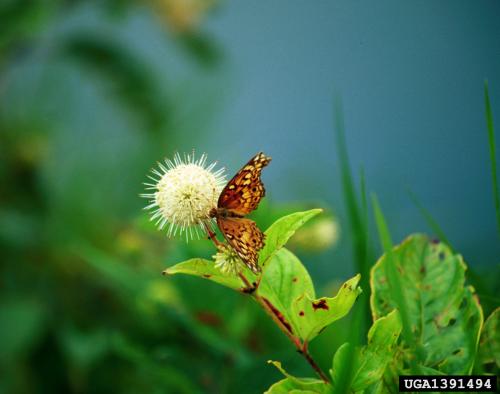
Smart Gardening: Trees and Shrubs Suitable for Michigan Landscapes
DOWNLOADDecember 20, 2023 - Questions about this information? Contact us.
Beautiful landscapes begin with a strong foundation of woody trees and shrubs. Beyond the popular array of easy-to-find exotic plants, there are many native plants that can provide natural beauty and enhanced habitat for wildlife. When properly selected and placed, native plants also benefit our environment through reduced water use and less need for pesticides and fertilizers. To top it all off, native plants can result in lower long-term maintenance costs, increased plant hardiness and less work.
A word of caution when considering natives: Native plant promotions sometimes claim the benefit of “no care” and “no maintenance.” Unfortunately, this isn’t true. While we would all love a no-work garden, just like any plant in your landscape, native plants do require care.

What’s native?
These plants naturally occur in a particular region, ecosystem or habitat without human intervention. Native plants were present at the time Europeans arrived in North America. Some people have a very narrow geographic focus for their definition of “native” while some are content as long as the plant is native to North America.
Regardless of your definition, there are many plants to choose from. In fact, gardeners may be surprised to discover that some popular trees and shrubs (e.g., honeylocust, Kentucky coffeetree, Juneberry, potentilla, ninebark and several viburnums) are actually native to Michigan.
Being successful
The key to success with native plants is carefully choosing plants that match your site conditions. While some native plants are tremendously adaptable to a wide range of environmental conditions, many are quite habitat-specific. Before you start selecting plant material, know your site, including the exposure, soil texture, pH, fertility, moisture conditions, weed problems and the history of use. Try to match the site’s conditions to the plant’s natural habitat. Some discrepancies can be corrected with soil amendments, mulching, fertilization, and other techniques, but these solutions may not overcome a poor match between your selected plant and site. Match the native plant with its native conditions as much as possible.
Remember that while your landscape may be in the plant’s native range, it is important to understand that most residential sites, particularly in urban areas, no longer resemble original site conditions. Soil may have been disturbed or subsoil placed on the surface. Sites may have been further altered through compaction, pollution, salt runoff and removal of canopy trees that use to provide shade. The survival and growth potential of native species in these conditions may be no better or worse than non-native species.
For urban gardens, consider plants that are native to wet soils. Many plants native to river bottomlands are surprisingly adaptable to urban conditions. In their natural environment, these plants experience extreme fluctuations in soil moisture and oxygen. Researchers have found that these plants often can adapt to compacted, overly dry, or overly wet soils that are common to urban areas.
Here are a few examples of native trees and shrubs to consider for Michigan landscapes.
Trees
Black gum (Nyssa sylvatica): 30 to 40 feet tall. Slow-growing with lustrous foliage that transforms to vivid shades of orange, scarlet and yellow in autumn. Dark, blotchy bark and unique branching pattern provides winter interest. Fruit readily eaten by birds and squirrels.
Low-maintenance and tolerates wet, clay soils as well as salt. Slow to establish in urban areas but will establish moderately quickly in native areas.

Hophornbeam (Ostrya virginiana): 40 feet tall. Medium-sized trees noted for their fruits, which resemble clusters of hops. Considered difficult to transplant but very tough once established. Useful in dry locations for lawns, parks, naturalized areas and street trees.
Alternate-leaf dogwood (Cornus alternifolia): 15 to 20 feet tall. Frequently overlooked for landscape consideration. Offers a wonderful horizontal branching pattern that works great to break up vertical elements in the landscape.
Plant bears clusters of small white flowers and bluish-black berries. Leaves turn reddish in fall. Prefers partial shade but does well in full sun.

Shrubs
Blackhaw viburnum (Viburnum prunifolium): large shrub - 12 to 15 feet tall. One of several native viburnums that add landscape beauty throughout the growing season. Offers creamy-white flower clusters in May which give way to edible black fruit in early fall. Fall color is purplish to shining red. Plants develop into a large shrub or can be trained into a small, informal tree. Best in full sun to moderate shade.

Common ninebark (Physocarpos opulifolius): medium shrub - 6 to 9 feet tall. Rugged plant that flourishes in the toughest conditions. Grows well in sun or shade and varying soil conditions. Pink-white flowers in May and June followed by rose-red fruit enjoyed by birds in September and October. Bark exfoliates on older stems, adding to winter interest. Several cultivars are available.

Buttonbush (Cephalanthus occidentalis): small shrub - 5 to 6 feet tall. Glossy foliage that emerges in shades of red and green, changes to dark green in summer and then yellow-green in autumn. Creamy-white, spherical flower clusters in mid-July attract small butterflies. Thrives in wet soil and full sun. Will not do well in dry conditions. Tolerates high pH soils.

Additional resources
- Attracting Beneficial Insects with Native Flowering Plants (https://www.canr.msu.edu/resources/attracting_beneficial_insects_with_native_flowering_plants_e2973)
- MSU’s Native Plants and Ecosystem Services (www.nativeplants.msu.edu)
Other examples of native trees and shrubs
Trees
- White oak
- Bur oak
- Red oak
- Kentucky coffeetree
- Juneberry/serviceberry
- Common paw paw
Large shrubs
- Common witchhazel
Medium shrubs
- Red chokeberry
- Michigan holly
- Arrow viburnum
Small shrubs
- New Jersey tea
- Diervilla lonicera
- Shrubby cinquefoil
For more information on a wide variety of Smart Gardening topics, visit www.migarden.msu.edu or call MSU’s Lawn and Garden hotline at 1-888-678-3464.
This work is supported by the Crop Protection and Pest Management Program [grant no 2021-70006-35450] from the USDA National Institute
of Food and Agriculture.



 Print
Print Email
Email




